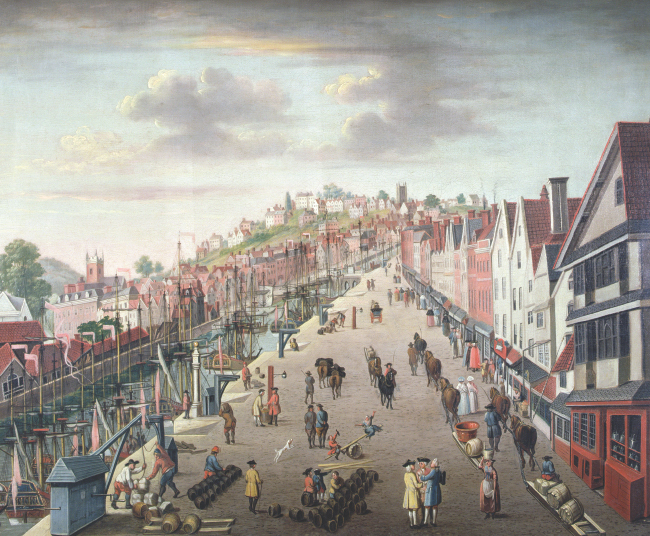A Servant Labor System.
Printed Page 57 Chapter Chronology
A Servant Labor System. Headrights, cheap land, and high wages gave poor English folk powerful incentives to immigrate to the New World. Yet many potential immigrants could not scrape together the money to pay for a trip across the Atlantic. Their poverty and the colonists' crying need for labor formed the basic context for the creation of a servant labor system.
About 80 percent of the immigrants to the Chesapeake during the seventeenth century came as indentured servants. Instead of a slave society, the seventeenth-century Chesapeake region was fundamentally a society of white servants and ex-servants.
indentured servants
Poor immigrants who signed contracts known as indentures, in which they committed to four to seven years of labor in North America in exchange for transportation from England, as well as food and shelter after they arrived in the colony.
Relatively few African slaves were brought to the Chesapeake in the first half century after settlement. The first known Africans arrived in Virginia in 1619. The "20. And odd Negroes," as John Rolfe called them, were slaves captured in Angola in west-central Africa. A few more slaves trickled into the Chesapeake region during the next several decades. Men and women of African descent occasionally became indentured servants, served out their terms of servitude, and became free. A few slaves purchased their way out of bondage and lived as free people. These people were exceptions, however. Almost all people of African descent were slaves and remained enslaved for life.
The overwhelming majority of indentured servants were white immigrants from England. To buy passage aboard a ship bound for the Chesapeake, an English immigrant had to come up with about a year's wages for an English servant or laborer. Earning wages at all was difficult in England since job opportunities were shrinking. Unemployed people drifted into seaports such as Bristol, Liverpool, and London, where they learned about the plentiful jobs in North America. Unable to pay for their trip across the Atlantic, poor immigrants agreed to a contract called an indenture, which functioned as a form of credit. By signing an indenture, an immigrant borrowed the cost of transportation to the Chesapeake from a merchant or ship captain in England. To repay this loan, the indentured person agreed to work as a servant for four to seven years in North America.

Once the indentured person arrived in the colonies, the merchant or ship captain sold his right to the immigrant's labor to a local tobacco planter. To obtain the servant's labor, the planter paid about twice the cost of transportation and agreed to provide the servant with food and shelter during the term of the indenture. When the indenture expired, the planter owed the former servant "freedom dues," usually a few barrels of corn and a suit of clothes.
Ideally, indentures allowed poor immigrants to trade their most valuable assets — their freedom and their ability to work — for a trip to the New World and a period of servitude followed by freedom in a land of opportunity. Planters reaped more immediate benefits. Servants meant more hands to grow more tobacco. A planter expected a servant to grow enough tobacco in one year to cover the price the planter paid for the indenture. Servants' labor during the remaining three to six years of the indenture promised a handsome profit for the planter. Planters also profited because they received a headright of fifty acres of land from the colonial government for every newly purchased servant.
About three out of four servants were young men between the ages of fifteen and twenty-five when they arrived in the Chesapeake. Typically, they shared the desperation of sixteen-year-old Francis Haires, who indentured himself for seven years because, according to his contract, "his father and mother and All friends [are] dead and he [is] a miserable wandering boy." Like Francis, most servants had no special training or skills, although the majority had some experience with agricultural work. A skilled craftsman could obtain a shorter indenture, but few risked coming to the colonies since their prospects were better in England.
Women were almost as rare as skilled craftsmen in the Chesapeake and more ardently desired. In the early days of the tobacco boom, the Virginia Company shipped young single women servants to the colony as prospective wives for male settlers willing to pay "120 weight [pounds] of the best leaf tobacco for each of them," in effect getting both a wife and a servant. The company reasoned that, as one official wrote in 1622, "the plantation can never flourish till families be planted, and the respect of wives and children fix the people on the soil." Nonetheless, women remained a small minority of the Chesapeake population until late in the seventeenth century.
The servant labor system perpetuated the gender imbalance. Although female servants cost about the same as males and generally served for the same length of time, planters preferred male servants, as one explained, because they were "the mor[e] excellent and yousefull Cretuers," especially for field work. Although many servant women hoed and harvested tobacco fields, most also did household chores such as cooking, washing, cleaning, gardening, and milking.